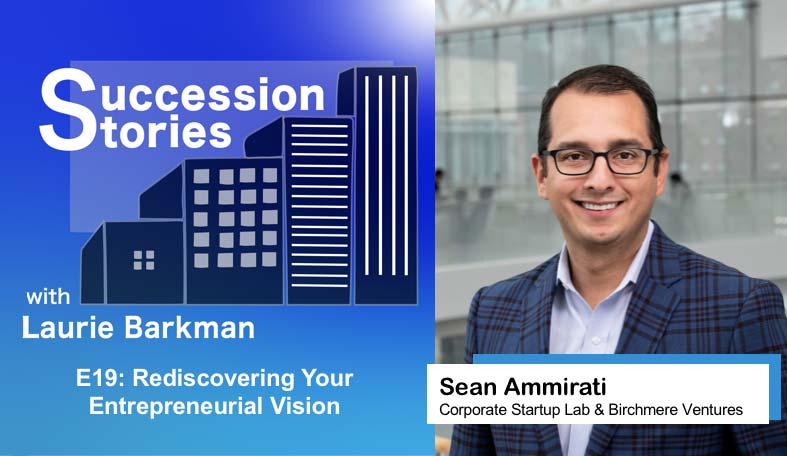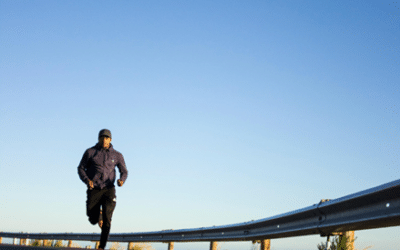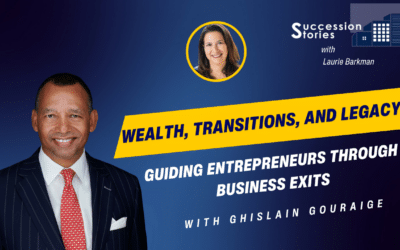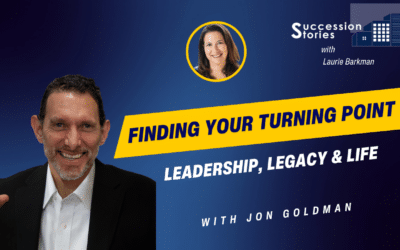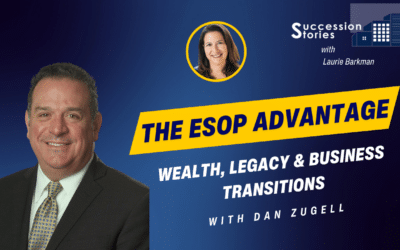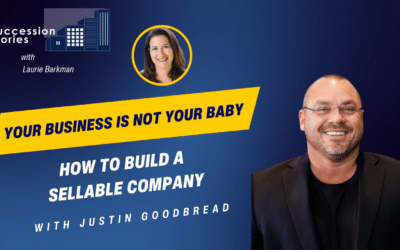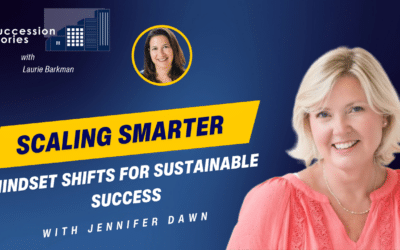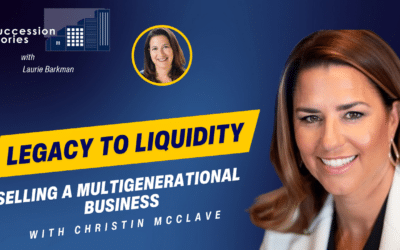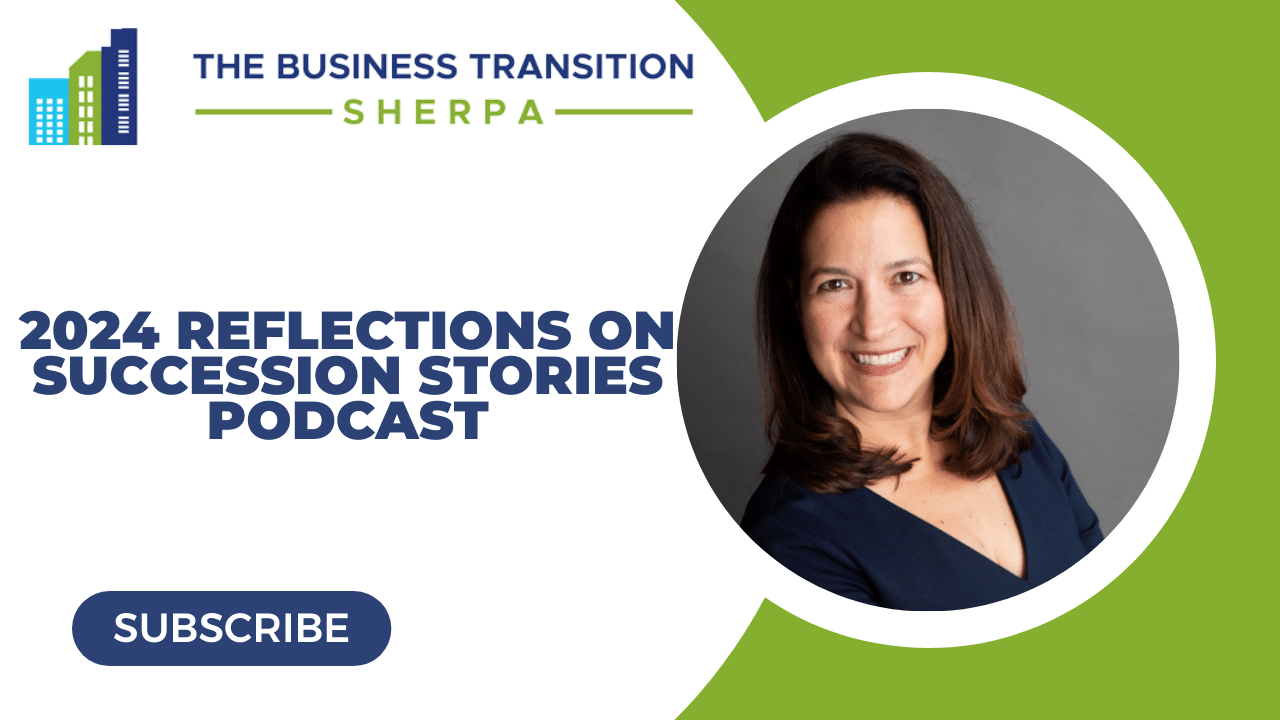Listen to the episode:
Shift your focus from maintaining your business to reimagining. Laurie Barkman is joined by Sean Ammirati, Co-Founder and Director of the Corporate Startup Lab and Partner at Birchmere Ventures. Listen in as they discuss how mature companies can rediscover their entrepreneurial vision and develop innovation strategies to thrive post-recession.
Subscribe to the podcast:
You can subscribe to the Succession Stories Podcast on Apple Podcasts, Google Podcasts, Spotify, Stitcher, or our podcast page.
If you enjoy the episode, please give a 5-star rating and review in Apple Podcasts or your favorite streaming platform to help others find the content.
Show notes:
- LinkedIn: Sean Ammirati
- Website SeanAmmirati.com
- Book: The Science of Growth on Amazon
- Corporate Startup Lab at Carnegie Mellon University
- Agile Giants Podcast
- Harvard Business School, “Roaring Out of The Recession”
- McKinsey article, “Innovation in a Crisis – Why it is more critical than ever“
Read the transcript:
Laurie Barkman: Sean welcome to Succession Stories. I’m really excited that you’re here today. One of the areas I love to explore on the show is innovation. I speak with privately held companies to hear how they did things differently. How did the next generation create value and grow from one generation to the next? And I’m excited to talk to you because I know that you share that same curiosity for how mature companies like family businesses drive innovation in their own way. So let’s start with you. Can you share your background and how you got started with your book, The Science of Growth, and creating the Corporate Startup Lab at Carnegie Mellon University?
Sean Ammirati: Sure. And first of all, Laurie, thanks for having me. It’s fun to do this. We’ve known each other for a long time and I’m just so excited the success that you’ve had with Succession Stories so far, and it’s just really an honor to be part of the community and now part of the guest list. So I appreciate you bringing me on. As you said, my background is a little bit of an interesting route to get into corporate innovation and how legacy businesses can become innovative. Because when I was at Carnegie Mellon and left to go do my first startup, I was fairly confident that my career would be one of building brand new high growth companies. So I left with Dave Mawhinney, who we both know, and a couple of other guys, Dean Thompson, to get involved in a couple of different high growth companies back to back.
Sean: So these were brand new small companies that were startups though. And, and so when I think of startups, what I think of is as things that start small with the goal of them becoming big, right? And the easy example of that is three or four people come together around an idea. They coalesce around that idea and their hope is that ultimately that becomes hundreds or thousands or tens of thousands of employees and thousands or millions or hundreds of millions of dollars of revenue. Right. To me, that was what a startup was. It looked just like that. And then in 2016, I had a book that came out called the Science of Growth, which was really targeted at that exact audience, those small companies that are brand new with the goal of them becoming big. But one of the surprising things that happened was lots of large companies, both publicly traded large companies, as well as family businesses started buying the book and giving it to their teams with the goal of those companies rediscovering their entrepreneurial roots.
Sean: What I realized is, man, these big companies can have startups too. And in fact, the more time I spent with them, I realized for a lot of them, it’s really about a process of rediscovery. Because every big company that’s established at one point was a small company that was just starting up by definition. And part of what we had to do is help them rediscover that process of being entrepreneurial. And so that’s what we’ve been doing for the last four years at the Corporate Startup Lab. And I say, we, because, as people on your show may or may not know, you’re actually, have been really involved in this since the beginning. So I think you were literally one of the first calls when we started formalizing this and making it more than an interesting idea, but actually kind of a project at CMU.
Sean: And then this year you actually helped me teach our major class. That’s the anchor of the lab at Carnegie Mellon where large companies come to us and they say, here’s a startup idea that we have for our established business can you help us flush this out. So this is certainly as much my story as yours, but we started the Corporate Startup Lab in 2017 and it’s gone through a bunch of iterations from there to here, but really focused on this- how do you help big companies rediscover their entrepreneurial roots and create these new projects inside, that again, just like a traditional startup start small with the goal of it becoming big.
Laurie: Yeah. And I remember calling you. I remember seeing the announcement that this was getting launched – the CSL for short – and feeling somewhat validated, like, wow, I’m not weird. You know, I’ve worked in startups and I’ve worked in these mature companies, publicly traded, large corporates, large billion dollar family, closely held companies. And, yet this juxtaposition back and forth is, I’m not alone in this, and this interest of working with big companies, as you said, to help them rediscover their entrepreneurial roots. And I think for people like me who have seen ourselves as intrapreneurial, the person inside of a large company that’s going to help move something forward. That was why I reached out. And I think why I’m so excited to have you on today because I think there’s a lot of really cool things for us to talk about regarding innovation and why it is challenging for established companies. Today’s show by the way, I love that we’re going to have more of a dialogue as opposed to an interview.
Laurie: I think there’s so many things for us to cover. And I was thinking also, particularly because of this crisis that we’re in. This is not the only time in our history of being in business where we’ve had crises. There are other points in time we can look at. And the research shows that companies that continue to innovate and don’t give up on those initiatives are more likely to benefit in the future. It strikes me as even more important now that companies who are considering maybe abandoning their innovation projects or initiatives to focus on their core, sustaining their company, and maybe think, oh innovation is that next big invention. I’m not going to go focus on that. I thought maybe that’s a great place to start for us because really it’s defining what is innovation, and what does this mean for companies who are looking to allocate their resources. Innovation does not necessarily mean an invention. Innovation is more about this continuous process of creating value. How do you see innovation?
Sean: Yeah. So I think about innovation similarly. So there’s different pieces of this. One interesting way to segment it is how much of this innovation impacts our current customers versus brand new customers. So you kind of think of that as one dimension of a spectrum of the Y axis, if you will. And if the X axis then is how much does this use our existing assets versus brand new assets? So you could have brand new-brand new, new-old, new-old, or you could have existing-existing, right. And if you think about those different buckets, it’s important to be applying entrepreneurial thinking and innovative thought across that whole spectrum of activities. However, they’re different activities too. So when you’re trying to make something 5% better, the next version of your product, that’s important so your product doesn’t become stale.
Sean: But that’s very different than launching a brand new line of business or what people would typically call kind of more transformational innovation. To your point on economic recessions, it’s a really interesting thing. The counter to this is there aren’t many recessions that are tied to a pandemic at the same time. So you have to go back quite a ways to find good data on that. But you can look back over each of the prior four or five recessions and see what happened to the different companies. Some companies went out of business. Some companies kind of bumped along the bottom for a while and ultimately came back. Some companies ultimately came roaring out of that recession. There’s a number of studies that different firms have done on this.
Sean: The one that’s actually my favorite, it was done by the current Dean of the Harvard Business School. It’s called “Roaring Out of the Recession.” It’s a pretty well-known HBR case study. But what they did is they categorized these and then they looked at how did those companies allocate their resources through the recession so that they came out of the recession not just okay, but actually stronger than they went into it. And I think what you’re going to see in this recession is the same thing’s going to happen. A segment of the companies are actually not going to just do okay coming out of the recession, but they’re going to ultimately come out of the recession in a better position than they went into it. Whereas, a lot of them unfortunately are probably trending towards a much more challenging situation or some of them will ultimately fail obviously.
Sean: What you see is how they invest in new products and new services, how they reallocate their teams to be more focused on innovation, dramatically increases the chance of them ending up in that bucket that ends up “roaring out of the recession.” And this is across, I think the last five economic corrections. So you’re talking about both things like the 2008 crisis, as well as 2000-2001 internet bubble and 9/11. So, there’s very different kind of impetuses of the economic challenge that put these companies in these challenging situations. But you see relatively consistent things that ultimately make those companies stronger. You know, again, you can make the argument, well, none of those were a pandemic and that’s true. But to me, the pandemic is only an even stronger accelerator. Like my sense is the companies that you work with. What they’re seeing is the things that they thought they were going to experience 5-10 years from now, they’re experiencing today or over the next 6 months. And so it’s only accelerating the trends that you would typically see in a recession.
Laurie: Yeah. And it makes me think about why are things challenging for well established companies? Why do they have an innovative culture or why do they not? And maybe our answer would be different five months ago versus today. There’s a McKinsey study that came out recently that polled executives and showed a significant decrease in the focus on innovation initiatives versus prior to the crisis, it dropped like a third. Folks in the past had said 60% of the resources were going to be allocated on those initiatives. Whereas now it’s more like 20% and that’s understandable. Again, people are focusing on the core. So it makes me wonder if our answer would be different if we said, well, why is innovation challenging for well-established businesses? And maybe our answer would have been different than it is today. So perhaps let’s talk about that. What do we think in the general scheme of things? Is it resource allocation that makes it the number one challenge? Some information I’ve seen says if you don’t get the aspirational part of it right– if you don’t get that top down part along with the commitment for resources. So again, allocation, and resource allocation. Do you believe that’s the biggest why?
Sean: I think you can’t do innovation with no resources, but rarely are resources the things that are holding these projects back. I’d be curious what you’re seeing with the folks that you talk to because you have so many people who are on the ground, operationalizing both the innovation strategies at the company levels, as well as the executives that you’re coaching through this process. But part of what I’m seeing is some companies, I think it was a bit of innovation theater. It was like, we need to do this because, I think what the McKinsey study is actually reflecting is a lot of those guys going away. But I also sense that there’s a group of these companies that are at least as committed if not more than before to the things that made us relevant are not going to keep us relevant.
Sean: And we must right now double down on this. And my sense is that those are the companies that are gonna “come roaring out” of this recession. But I think what you’re seeing is a real delineation of people who are really committed to it, versus people who it was kind of lip service, innovation theater, whatever. But you’re closer to it. And I think you also, because of the executive coaching on top of the other stuff you do, without disclosing any specific client, right, I think you have a sense into what’s driving this from a leadership perspective, and I’d be curious what your conversations in aggregate, anonymous, how they are going with your clients right now on this topic.
Laurie: Yeah, I think it’s for many about survival to the next week, month, what have you. That was sort of part one. Now what I’m hearing is more of that desire to rethink the marketplace, understanding the competitive dynamics have shifted. So where there were aspirations for digital transformation and really implementing sustainable, scalable processes. It was perhaps in a less accelerated way. And now it’s this is the new way we’re going to do things. And before I’m not sure what their answer would have been to this question, but I think it’s a good question to start with for any business owner or executive, which is…is innovation absolutely critical to your future growth? Perhaps for more of the stable businesses that were able to more accurately forecast, and probably down to the penny of where their business was going to be in the following year, now, they’re not sure. And there’s a gap. And so perhaps in the past it was, well, if we do these risky things, we can’t necessarily count on that driving incremental growth to our company, whereas we can more accurately forecast our predictable revenue from the past and profitability from the past. So now it’s kind of shaking it up a bit. And so what I think is the answer to that question is now going to be more yes’s and probably’s than it would have been 6 to 12 months ago.
Sean: That’s really interesting. And I think that’s, I mean, not surprisingly, I think that’s exactly right, Laurie. There was a period of time, I think for most people, this was March and maybe early April, which was kind of like, okay, we need to survive day to day, week to week. But then I think what I’ve seen insightful executives do, and I think that was a great way to expand on this, they’ve shifted their focus from, okay, how do I reopen my business, whatever that means…to how do I reimagine my business. I think they knew this before, but the time horizon was longer. It was like, well, the things that made me relevant, aren’t going to keep me relevant, but maybe they thought there was a 5 to 10 year tail on that. And now they think maybe there’s a two to three month tail on that. And so they’ve got to quickly move. And I think shifting this focus from reopening to re-imagining and entrepreneurial thinking and this kind of innovative approach is crucial to make that happen.
Laurie: Yeah. I think it is. There’s a couple of examples of folks that have been on my show. So I think it’s going to be fun to share some of these and encourage listeners to go check out those episodes. There’s a sixth generation CEO that I spoke with…sixth generation! Just pause on that…their company was started in 1855. So as you look at a company like theirs, which is a funeral and cremation services, right, you’d say, oh, innovation really? Yeah, we talked about innovation and their business and it was part of their culture and DNA as their leadership was looking for opportunities in the marketplace. And I loved my conversation with Michael because he gave examples of going from horse and buggy to a hearse, a motorized, something that carried…that’s a great example, an initial example that we can all kind of chuckle at that – to air conditioning, which back then was again an innovation.
Laurie: It was customer experience. And for them, it goes with the definition, I think of innovation, which is innovation creates value. There was a quote recently that I heard from one of the speakers in your class. And she said, “There’s a difference between creativity and innovation. Creativity is you spend money to create ideas, and innovation is you generate ideas to create money.” I love that quote.
Laurie: And I think for the Schoedinger Funeral Cremation Services, it led them eventually to looking at the marketplace saying, hmmm, we can expand to pets. And they did an entire market study and interviewed 130 veterinarians and developed a market for pet funerals. So here’s this very stable, very conservative, it’s a funeral business, but such a great example of some of the tenets that we teach in our class to the students, which is understanding the marketplace. Go talk to the market, go understand what the problems are, what challenges is your market facing, and then, what can you do to help innovate and solve those problems.
Laurie: So I thought it might be fun for us to talk about where we think the process may lead companies. Like where’s a great place for them to start? If they’re saying my business is more dependent now than ever on understanding my market. And so maybe we think about this from a sense of if we are going to help the audience in getting started, what might we say to them? What is step one?
Sean: I think step one almost always is get out of your building and go talk to your customers. And in 2020 that may mean get out of your sweatpants and get on Zoom to web conference with your customers. But the point is that great innovation almost always starts with understanding the real problems and pain that your customers have. Now, where it’s magical is when you then deeply understand that customer pain and merge it with your entrepreneurial vision to come up with the right solution. People will often push back on this, like, oh you got to start with the customer and they’ll use like the Henry Ford quote. If I asked my customers what they wanted, they would’ve told me a faster horse. Or they’ll say I didn’t know I wanted an iPhone until it was introduced.
Sean: I think both of those are kind of false choices. You absolutely knew the problem that your Blackberry had before the iPhone was introduced. The problem that every Blackberry had was they couldn’t open links on emails or to put it a little more general anything that wasn’t text wasn’t great on a Blackberry. Now, Blackberry was magical from a text perspective. I was very addicted to my Blackberry. My wife would call my Blackberry my CrackBerry just to reflect how addicted I was to it. I was a big fan of it, but I absolutely knew that problem. I remember I would get on the subway. I would reply to all of the emails on my Blackberry, except for those that had links in it. And then when I would sit at my desk and lower Manhattan, I’d have to actually deal with those emails, the ones that had links in them. Now, I would not have told you the solution to that problem was to get rid of the keyboard.
Sean: In fact, I probably would have told you pretty strongly the keyboard was what made the Blackberry magical. But I knew the problem and the problem was well understood. And so what you do is you deeply understand the problem and then you apply your vision to it. And when you think about the conversation you had with Michael. I don’t know that he knew this is what he was doing. Listening to him talk, I think this just felt like the way that business works and I think that’s probably why it’s on generation six. Like, well, you get out of the building, you go talk to people you’ve learned, and then you apply your ingenuity to it. Without realizing it, this basically was the customer development model. Go out, run a bunch of interviews, learn a ton about the pain, the problems, the persona of your customer.
Sean: And then you apply your entrepreneurial innovation to solve that. Let’s learn about the customer experience problems. Let’s apply our vision of air conditioning over that. Let’s learn about the problems of pets. There’s a bunch of different stakeholders. We need to understand all of their concerns, pet owners, veterinarians. Now let’s apply our innovation on top of that. What customers are experts at is telling you the problems, the needs, things like that. What entrepreneurs are expert at is internalizing that and then applying their vision on top of it. If you’re going to say where do I start? The best place to start in my experience is going and talking to customers. Coming back to this, like helping companies rediscover their entrepreneurial vision, I think the firms that need help rediscovering that, or that want to accelerate that step one typically is getting them to do more of that. Those that are just continuing to reinvent the future, instead of having the future come at them, it’s just part of their culture. And I thought that the conversation you had with Michael is a great way to illustrate a firm where this had just become part of how that family runs their business.
Laurie: Yeah, absolutely. I agree. I think the discover phase is a great place to start assuming that the leadership has really nailed down that top-down message and allocating resources. It then becomes probably this resource allocation selection challenge. Kind of this portfolio approach, if you’re fortunate enough to have a lot of good ideas, choosing the ones to go work on becomes that next exercise. And we saw some of this machination in our class with the students. Of course in a semester long class, it’s only trying to give a taste of what this could be in a larger setting. And I think we saw some of this with the students where one team in particular went back and forth, and back and forth, because the selection of opportunity, there were no shortage of opportunities. It was the selection and the recommendations that really were getting them stuck. And I can imagine what this looks like for a company that maybe doesn’t have the experience to understand the risks and benefits. And so doing the math, if you will, it’s an art and a science. What is your experience with this portfolio approach of looking at risk and reward?
Sean: Yeah. So, a couple of things. We talked about incremental versus transformational, right? And I think the reality is you need to manage the portfolio of those differently. But the interesting and exciting part is that outer edge of the matrix is sort of new markets, new assets, the more transformational part of that. That’s where this portfolio approach becomes really interesting because just mathematically, many of them are not going to work out right there. You’re going to be wrong on some of the hypotheses that you have about solutions to customer problems even if you’re really good at understanding their problems. You’re also going to realize, as you spend more time with customers, that what you thought was the pain and the problem that they had is not exactly what it was. And so what I see some executives try to do is say, okay, I want my company to be more innovative.
Sean: I’m going to go all in on this one idea. And this one idea is going to be the thing that’s going to reinvent my company. Just probabilistically the likelihood is that they’re going to regret that in 18 months because there’s a bunch of different data, but what most people will tell you, somewhere between 10% and 40% of startups don’t work out. Now, I think the way you go from 5% to 10% success rates to 40% to 50% or 30% to 40% success rates is by getting good at talking to customers early. But either way, if you knew you had somewhere between a one and ten, and a three and ten chance of succeeding, would you put all your resources against that one thing and hope it succeeds? Absolutely not. But what you think about is if that one succeeds, the payoff might be at 10X, 100X, 1000X, right?
Sean: And so if you can do 10 of them. Instead of thinking about it as one risk, think about it as 10 or 15 risks. Now, all of a sudden on a weighted average basis, you’ve got a much higher probability of succeeding in aggregate. The other thing that we can do, and I actually know that this is often part of what your strategic planning does with these companies as well, is help them think about multiple phases that they can bring these processes through or gates that they can bring these ideas through. So, now you’re not even equally spreading dollars across all 10 or 15 of them. You’re saying let’s spread, 1/50th of my money across these 10. So the first 10% of my total dollars go to this early phase, eliminate half of them, then take the half that continue. Spend another 20% of my total budget on those.
Sean: Now I’ve narrowed it down to two or three. Okay, let me take the bulk of my money and put it against these two to three. Just from an asset allocation perspective, you’re going to end up with a much higher return on investment modeling out your projects like that. I think that process is important and getting top down mandating that process is important. It’s something that we’re just beginning to look into at the Corporate Startup Lab and run some Executive Education programs around it. We’re going to pilot our first one on this portfolio theory this fall. But I think the other part of it is- it doesn’t work if you don’t have the right strategy behind it. You’ve ended up helping a lot of companies think through exactly this, because part of what happens is when you have the right strategy, you sort of have the frame or the canvas that you get to paint in, and that actually makes your team much more creative. So maybe it’d be interesting to talk for you to talk just a little bit about how you help companies develop these strategic plans.
Laurie: When we talk about strategy, how I work with clients, I like to talk about the strategic planning process, because a lot of things that we’re talking about here, it really starts at the top. So we talked about aspiration and that commitment. And then you say, well, where do we see ourselves and doing the research. I mean, it’s one thing to just sit in a room and pontificate and have a conversation and create whiteboards, but it’s virtual whiteboards now, doing it online.
Laurie: But it’s another thing to really roll up your sleeves and look at the numbers and look at the data. I’m a big fan of doing the research, looking at your own numbers, trying to assess the marketplace. And so when you come together as a leadership team, whether it’s, you’re doing it yourself, where you have an outside facilitator doing it, you know, whatever your process is, I think what’s really important is starting with facts. And then you can kind of get into this art and the science of conjecture and intuition and where we think things are going. But the facts can also be, as you said earlier, coming from the marketplace and talking to customers. So all of that is pre-work, and that’s not easy, but that’s important. And so that step, call it step zero, if you will, even before you start to have your planning sessions. So for me, and working with clients, that’s really where it starts.
Sean: I want you to add, because I think again, as an outsider I’ve observed your process, there’s a mix of qual and quant that I think is particularly powerful there. So the shorthand, I would usually say to somebody is like, and those facts mostly are outside the building or on Zoom now. And I think that’s still a pretty good, quick heuristic. What I think you do that’s really magical in this process is it’s a mix of customer interaction, market research, qualitative, and quantitative together that I think paints this like really strong picture for people. And so maybe just take a minute more to talk about like, okay, so you got to start with these facts, but, but if somebody doesn’t know where to start gathering those facts or how to think about organizing them, what would you encourage them to think about?
Laurie: Yeah. So one framework is the SWOT analysis. And so it stands for Strengths, Weaknesses, Opportunities, and Threats. And so there’s facts to gather underneath each of those, what are your business strengths and weaknesses? And those are aspects that are internal to the company. So a strength might be the strength of your brand. Well, is that measured? How do you measure that? There are some companies that measure that, especially in retail, they’re outside resources that can tell you the strength of your brand. If it’s not measured through a third party, then maybe you’ve done customer surveys. Maybe you have satisfaction surveys or net promoter score, things of that nature. So there’s things that you know about the strength of your company. Maybe it’s the strength of your employees, the retention you have, the engagement scores you’ve gotten on internal surveys, things like that. So these are things internal to your company– the strengths as well as the weaknesses. The opportunities and the threats are external.
Laurie: And so these are more like the market dynamics of regulatory, technology improvement, things happening with technology. These are environmental related. Threats can come from weather, for example, depending on your business, growing crops and you’re looking at all of that. So it really depends on the nature of the industry. It can be competitive threats. External can be competitive threats. And so you take all of that and that’s fact driven. Then you come together with all of that and cull it down. And pretty quickly what starts to emerge are really core themes of problems to solve. If your brand’s problem is the top three things that are coming out in this process, it’s pretty hard to ignore. And so goal setting, is it emanates pretty readily from that exercise.
Sean: And that’s where strategic planning versus customer discovery, I think should be the beginning point of it so that you really understand where the world is heading and the new problems, new opportunities, new pains, new jobs to be done by your customers or for your customers.
Laurie: And I can see some people saying, oh, I need to create a separate organization. And I would say, don’t do that. The organization comes later. It should come once you know what your innovation focus is. So I would say wait to mobilize your team. Let that be an outcome as opposed to step one.
Sean: Yup. And I think there are different…we’ve seen really effective spread this across the organization as well as there’s a core team who’s responsible for this. So I’m just not at a point where I’m comfortable saying prescriptively one structure is better than the other. But I agree either way, these start feeling more like experiments and later become organizational efforts.
Laurie: Okay. Well, let’s switch it up a little bit more back to CSL. There’s a lot of things going on. Why don’t you tell us a little bit about what’s up for CSL later this year?
Sean: Yeah. So we’ve got some Exec Ed programs coming up. We’ve got our Forum which likely at this point will be a virtual forum. You were actually one of the moderators for our initial one we did last December- December of 2019. Coming right out of that, we announced that we were going to do it in November, just to fit a little bit better on people’s calendar. At that point, when we made that announcement had no idea that we’d be living in a pandemic. Currently we’re thinking early November. But I think if we move it online, it may be shorter. Instead of one full day, it may be a couple of days. In November, we’ll be doing what we call the Corporate Entrepreneurs Forum which is a great kind of multi session event looking at corporate entrepreneurship.
Sean: And then obviously the course that we’ve referenced earlier, we’ll be doing that again in January of this year. And the idea behind that course is, we take companies who have innovation challenges, and we pair them with teams of graduate students from across Carnegie Mellon. We literally had every group on campus – every school on campus represented. We had 12 majors and all six schools represented working together in interdisciplinary teams as almost outsourced entrepreneurs with guidance from myself, you, and then one other instructor to helping make this, helping them explore as almost an outsource corporate entrepreneur team. So that’ll kick off again, January, 2021.
Laurie: And how about for the class, if there’s maybe anyone listening that is thinking that maybe learning a little bit more about the class itself. What types of sponsors do you look for?
Sean: Yeah, so we’re looking for established businesses that want to reinvent themselves. So we’ve worked with a couple of different family businesses. We worked with Tunxis which is a family business up in Connecticut, started in the construction industry and it has expanded to be construction entertainment. We also work with the business that for your local listeners, they may not think of as a family business, but it really is– Giant Eagle. We helped them imagine and work through some ideas on future of grocery commerce as well as we’ve worked with non-family businesses. We worked this past year with Optum which is part of United Healthcare, as well as Bosch, which a large automotive supply chain business. We’ve done stuff in the past with Alcoa, Verizon, so large established businesses trying to reimagine themselves and touch on many of the things we talked about today.
Laurie: So how can people find you? How can they find you for more information about CSL or your book? And you also have a podcast which we mentioned earlier called Agile Giants. How do we find you out there on the internet?
Sean: Yeah. Agile Giants, you can find it wherever you listen to podcasts. In terms of the Corporate Startup Lab, it’s corporatestartuplab.com, and you can see things about the course, the programs we run, all of that is on the site. And then for myself, probably the best jumping off point, which will lead you to the podcast, that will lead you to other projects and courses and things I’m doing is SeanAmmirati.com.
Laurie: Awesome. And your book, of course, The Science of Growth, is available on Amazon and your website.
Sean: Amazon and everywhere. My publisher has done a good job. Buy it from a local bookstore or Amazon, whatever you want.
Laurie: That’s amazing. There’s lots of great ways to get in touch. Sean, thanks so much for being with us today. I want to end with asking if you have a favorite quote about entrepreneurship. I’m sure that you do.
Sean: I do.
My favorite definition of entrepreneurs is that entrepreneurs are people who look out into the world and imagine how the world ought to be and then build products and services that make the world as it ought to be.
Think about all the different ways the world is more magical today than it was 20 years ago. Behind every one of those innovations, there was an entrepreneur who made that happen. Now some of those were corporate entrepreneurs like Steve jobs and the iPhone. Some of those were traditional entrepreneurs, you know, brand new companies that changed how we byproducts services, whatever. But from the Peloton or the Tesla in your garage or basement, to the iPhone in your pocket, there’s an entrepreneur behind every single one of those products.
Laurie: And you are behind so many innovations too. And it’s so fun to be with you today. This was really cool. We’ve been on each other’s show. We worked together in a variety of ways and I’m just so glad we had the opportunity to talk this way today.
Sean: Yeah, thanks Laurie. It was really fun.
Laurie:
Innovation. Transition. Growth. Easy to say but hard to do. If you’re an entrepreneur facing these challenges, I get it. I work with businesses – from small to big – for strategic planning with your team to achieve your vision. Visit smalldotbig.com to schedule a call with me. I’d love to connect with you.
Be sure to catch the next Succession Stories episode with more insights for next generation entrepreneurs. Thanks for listening!

